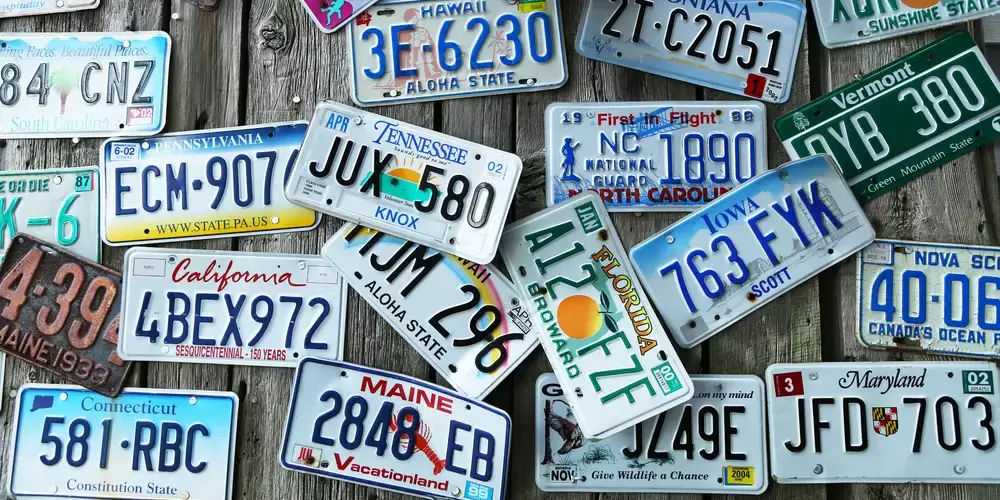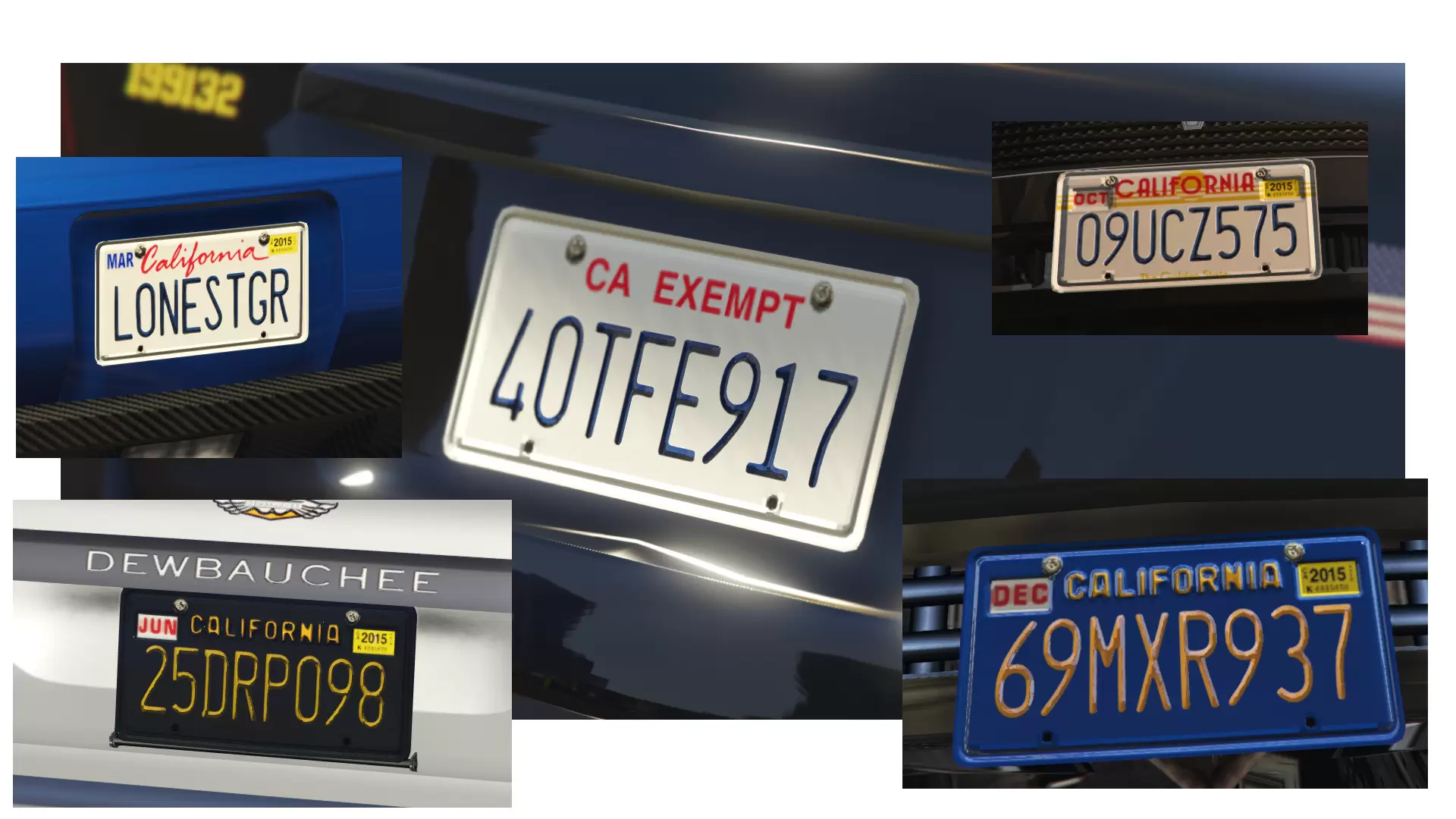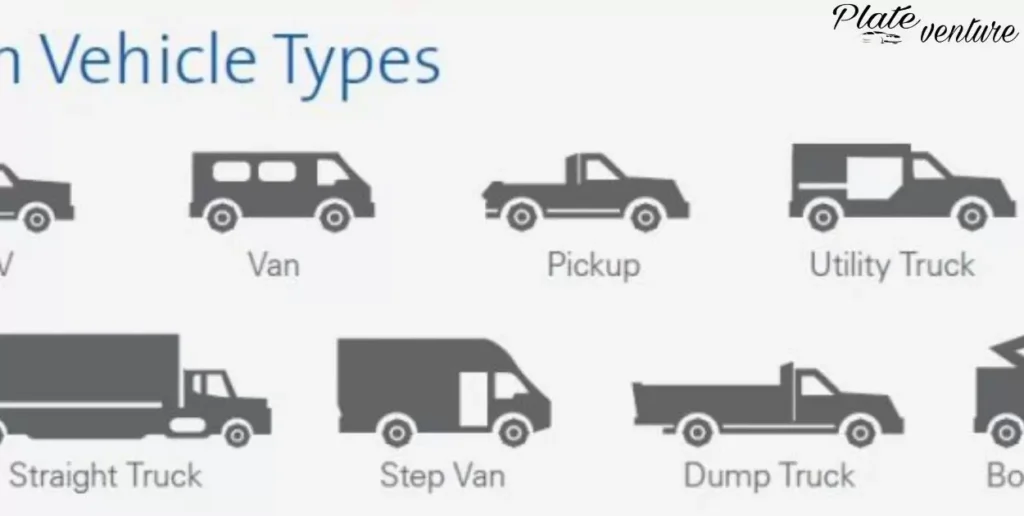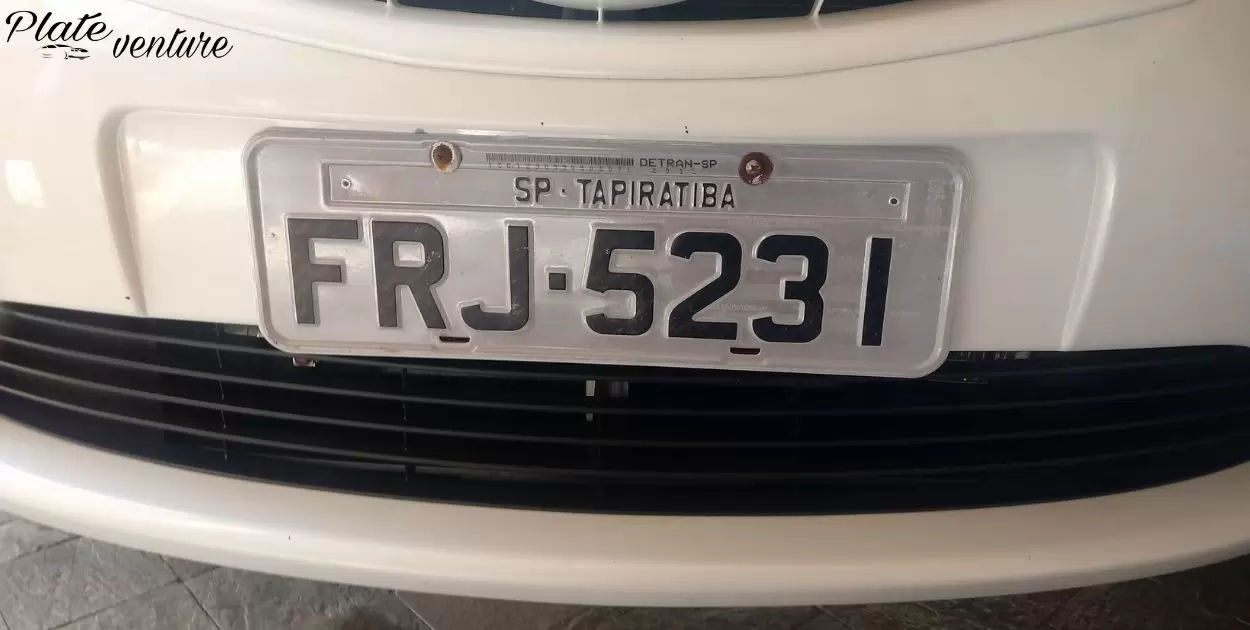A standard license plate in the United States measures 6 inches by 12 inches. This rectangular size is consistent across all 50 states and meets the basic dimensional requirements for license plates specified by law. With 30 square inches of space, the standard plate provides sufficient room for the plate’s unique identifying numbers and/or letters, as well as the state name printed across the top.
How Big Is A License Plate? While most of us see license plates every day, we seldom stop to actually measure them and appreciate the thought that goes into their standardized size. This overlooked detail raises an interesting question about why plates around the country share the same 6″ x 12″ dimensions.
License plates have been made in the same general 6″ x 12″ proportion for decades. This consistent sizing, regardless of your state, allows plates to fit into common license plate frames and holders. It also provides adequate space for jurisdiction names, plate numbers, slogans, and other design elements that help make each plate unique. The standardized size strikes a useful balance – not so small that text is illegible, but not so large as to take up unnecessary space on vehicles.
How big are standard license plates in the US?
The standard dimensions for license plates in the United States are 12 inches wide by 6 inches tall. This rectangular size is consistent across all 50 states for regular vehicle plates on cars, trucks, and trailers. Some exceptions exist for speciality plates like motorcycle plates (4 by 7 inches) or golf cart plates. But 12 by 6 inches is the common standard.
What are the dimensions of a standard US license plate?
As mentioned above, standard US license plates measure 12 inches wide and 6 inches tall, giving an overall size of 12 x 6 inches. This allows enough space for jurisdiction identification, plate numbers, slogans etc while still being appropriately sized for visibility on vehicles. The consistent sizing aids recognition and administration.
How thick are license plates usually?
While there is no single defined thickness, license plates typically range from 0.025 inches (0.5 mm) to 0.039 inches (1 mm) thick. Thicker plates are more durable but thinner ones use less material. Durability and cost are balanced in setting typical plate thickness.
What shapes can license plates come in?

Despite some variation globally, license plates in the US and North America are predominantly rectangular in shape. The 12 x 6 inch size plates used across the US states are rectangular. Some alternate shapes like ovals, squares or complex cutout designs are used for speciality plates, but mainstream plates are rectangular.
Why are license plates a standardized size?
Standardization of license plate size, at 12 x 6 inches across US states, aids administrative efficiency and visibility/legibility. Consistent sizing means plates fit within existing infrastructure like mounts, brackets and frames. It also assists with borderless travel across state lines and plate recognition technologies. Enforcing a common size and shape benefits road agencies and motorists alike through simplicity and compatibility.
What factors affect license plate size?
The main factors that impact license plate size are visibility, aesthetics, and legal requirements. Regions that prioritize visibility tend to use larger plates that can be easily spotted at a distance. Smaller plates are preferred for aesthetic reasons in places that want a clean, compact look.
There are also legal size requirements that plates must adhere to, which vary by jurisdiction. For instance, standard US plates are around 6 by 12 inches, while European plates are typically taller and narrower. 3 Beyond basic size, other design choices like font, spacing, materials, and embellishments also influence the final dimensions.
How does plate design impact the size?
The design elements of license plates influence their size. Can-Am Spyder license plate size is determined by factors like information displayed, visual elements, and lettering spacing.
Standardized plates are usually more compact, while vanity and specialty plates may be larger due to customization. Materials, such as metal or plastic, also impact the size. Understanding these factors is crucial for ensuring compliance with the designated Can-Am Spyder license plate size.
Do specialty and vanity plates have different sizes?
Specialty and vanity license plates frequently diverge from standard sizing. These customized plates allow more flexibility in layout and graphics, resulting in larger dimensions.
They may contain extra text for fundraising or awareness campaigns, or intricate designs that take up more surface area. Since vanity plates are meant to attract attention and make a statement, they tend to be bigger and bolder.
Even with creative freedom, these plates still have to meet basic legal guidelines. So while they push the boundaries of size, specialty and vanity plates cannot go beyond established maximum measurements.
How does the mounting hardware change the dimensions?
Mounting hardware like bolts, screws, frames, and brackets can subtly alter license plate dimensions. Security screws tend to be wider, increasing the overall width. Decorative license plate frames can add thickness along the edges.
Brackets may protrude slightly, expanding the outer boundaries. Even the vehicle’s bumper size and curvature can necessitate adjustments. These changes usually amount to marginal differences.
Strict legal limits prevent mounting equipment from significantly changing a license plate’s fundamental length and height. The hardware simply enables proper installation within standard constraints.
What vehicle characteristics determine license plate size?

A vehicle’s size, shape, and design dictate some license plate specifications. Larger commercial trucks and construction equipment require bigger plates that can accommodate larger lettering visible at a distance. For smaller cars, compact rectangular plates are suitable.
Vehicle contours like curved bumpers can call for specialized plates that conform to the bodywork. Front license plates tend to be smaller since the rear is the primary identification point. Sports cars favor slimline plates that integrate cleanly without disrupting aerodynamic lines. So while legal dimensions stay consistent, some vehicle-specific traits inform ideal proportions for functional and aesthetic harmony.
How do European license plates compare in size?
European license plates are generally larger than US plates. The most common size is 520 mm x 110 mm (20.5 inches x 4.3 inches), making them taller and narrower than the standard 12 inch x 6 inch US plates. European plates are often rectangular while US ones are more square.
What are the standard dimensions of European plates?
The standard European license plate size is 520 mm long by 110 mm tall (20.5 inches x 4.3 inches). This size is used in many European Union countries and follows an ISO standard. Some countries use plates as large as 520 mm x 120 mm or as small as 297 mm x 100 mm.
How does plate size vary between European countries?
While the 520 x 110 mm size is common, European plate sizes are not uniform across countries. Germany, Spain, Italy and others use this size, but the UK uses 520 x 111 mm plates. Some countries like Switzerland use smaller 297 x 100 mm plates. Specialty and older plates in Europe may also differ in size.
What shapes are common for European plates?
European license plates are typically rectangular in shape, with the length being much greater than the height. Some countries issue square plates closer in dimension to the US’s 6 inch x 12 inch standard size. But most plates are 20+ inches long by just over 4 inches in height, giving them a distinctly rectangular look.
Why are European plates often taller than US ones?
5 easy short benefits explaining why European license plates are often taller than US ones:
- Fit more vehicles – European plates are made to fit many car models.
- Display country code – Extra height shows the country identification code.
- Customizable plates – Tall plates allow more space for personalized plates.
- Visibility – The tall rectangular shape is easy to spot.
- Aesthetics – Many people find the European plate proportions more visually appealing.
Why do some states have smaller license plates?
Some states issue smaller non-standard license plates, usually for motorcycles or other small vehicles. Smaller plates help accommodate the limited space available on these vehicles. They also suit the aesthetic preferences in certain regions.
For instance, European style plates tend to be longer and narrower. Smaller sizes may also reflect cultural nuances or legal requirements in some jurisdictions.1
What states issue smaller non-standard plates?
Some states issue smaller license plates. These are non-standard plates. They are usually for motorcycles or mopeds.
The table below shows some states with smaller non-standard plates:
| State | Smaller Plate Size | Used For |
| Minnesota | 4 x 7 inches | Motorcycles |
| Maryland | 4.5 x 7 inches | Motorcycles |
| Puerto Rico | Varies | Extra fee plates |
The standard size for license plates in the US is 6 x 12 inches. Smaller sizes are for special vehicle types. Motorcycle plates are commonly around 4 x 7 inches in size. Puerto Rico allows smaller European sized plates for an extra fee.
For what vehicle types are smaller plates common?

Smaller license plates are very common for motorcycles and small trailers where space is limited. Since motorcycles lack a prominent front bumper, they require specialized mounting locations and compact plate sizes to fit. So most states issue motorcycle plates around 3 by 6 inches, less than half the dimensions of a standard plate.5
What issues arise from smaller license plate sizes?
The main drawback of smaller plates is reduced visibility and identification ability, especially from a distance. This causes issues for easy recognition on roads compared to larger plates. Smaller surface area also restricts the flexibility of plate design and limits the use of special slogans or logos. Enforcement can become difficult with plates that are hard to spot.1
What regulations dictate minimum plate sizes?
Individual states and jurisdictions regulate the acceptable minimum dimensions for license plates issued within their borders. However, no universal federal standard exists across all 50 states.
The American Association of Motor Vehicle Administrators has pushed for some level of standardization, but significant diversity still remains between regions.5 Most states comply with the commonly used 6 by 12 inch plates for regular passenger vehicles.
How can I measure a license plate?
To measure a license plate, you will need a ruler or measuring tape to measure the length and width. Place the plate on a flat surface and measure across the longest dimension for the width, and across the shortest dimension for the height or length. A caliper can also precisely measure thickness.
What tools do I need to precisely measure plates?
The best tools to precisely measure license plates are a steel ruler, measuring tape, and a digital caliper. The ruler and tape will allow you to measure length and width, while the caliper can precisely measure thickness of the plate as well as screw diameters. These tools will provide the most accurate license plate dimensions.
What are the key dimensions to measure?
The key license plate dimensions to measure are:
- Length – The short side, usually around 6 inches
- Width – The long side, usually around 12 inches
- Thickness – Typically 0.06 inches for flat plates
- Screw diameter – Typically 1/4 inch or M6 metric
- Screw length – Typically 3/4 inch or 16-20mm metric
How do I account for the mounting hardware?
When measuring for mounting, add approximately 0.25 inches of margin around the edge of the plate to account for the mounting hardware and ensure screws are not too close to the edge. The border space allows easy access for screwdrivers. Also ensure to measure screw lengths to match the bracket depth.
What should I do if my plate seems non-standard?
If a license plate seems an abnormal size, first double check measurements and ensure tools are properly calibrated. If still non-standard, check jurisdiction regulations as some allow alternate sizes, or contact the department of licensing to inquire if they can provide documentation on permitted plate dimensions.
Frequently Asked Question
What are the standard dimensions for US license plates?
The standard US license plate size is 6 inches high by 12 inches wide.
Do European license plates have the same dimensions?
No, European license plates are often around 520mm x 110mm to 520mm x 120mm in size.
Can license plates be custom sizes?
Yes, some jurisdictions allow custom license plate sizes, though standard dimensions are most common.
What is the size of a motorcycle license plate?
Motorcycle license plates are typically smaller at around 4 inches high by 7 inches wide.
Is there a minimum or maximum size limit for license plates?
Most areas require plates to be clearly visible and legible, with no universal mandated size limits.
Conclusion
Standard license plate sizes in the United States are 6 inches tall by 12 inches wide. This is the most common size for regular vehicles. Some states allow smaller sizes. Cars, trucks, and SUVs use the standard 6 by 12 inch plates. Specialty plates for motorcycles and trailers can be smaller.
There is no universal global standard for how big a license plate should be. Sizes vary between countries. They also differ by region and vehicle type within countries. Checking local regulations gives the legal size requirements. Carefully measuring existing plates or plate brackets also verifies the right size to buy. Correct sizes keep plates securely mounted and legally compliant.








